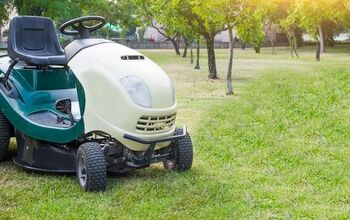Hydrostatic Mower Will Not Move? (Possible Causes & Fixes)

When it comes to riding lawnmower engines, hydrostatic drives are one of the simplest to use. Rather than having to shift gears manually, this motor allows you to adjust the speed quickly and efficiently with a press of the pedal.
However, while hydrostatic mowers are convenient and more comfortable to drive, they can still encounter problems. One of the most significant issues is when one of these machines won’t move.
Common reasons why a hydrostatic mower won’t move include: having old hydraulic fluid in the lines, having air in the lines, or a worn drive belt. Usually, the best way to fix these problems is to flush the hydraulic lines and refill them with new fluid. Also, you can change out the old belt for a replacement.
Since you need your lawnmower in perfect working condition, we’ll go over these problems in more detail and how to solve them.
Do You Need Landscaping Services?
Get free, zero-commitment quotes from pro contractors near you.

Reasons Why a Hydrostatic Mower Won’t Move
Old Hydraulic Fluid
A hydrostatic lawnmower uses hydraulic fluid to drive the transmission. When this fluid sits for a long time (i.e., over winter), it can lose many of its properties, meaning that it can cause transmission failure. In most cases, when one of these lawnmowers isn’t moving, the problem is likely old fluid. If you notice this issue happens mostly when you start mowing in spring, it may be useful to flush the system when putting the mower away for winter.
The Fix: Flush the Fluid and Replace ItIf you’re in a rush, you can take your mower to a specialist who can flush the lines and replace the old hydraulic oil. However, to save money, you can do it yourself. Simply open the drain plug and let all of the fluid drip out. Typically, this can take a couple of days at most. Once everything is out, you can refill the engine with new oil. Be sure to use compatible fluid for your lawnmower. You can often find the right mixture by checking the owner’s manual.
Air in the Lines
Another side-effect of leaving your hydrostatic mower idle all winter is that air can get into the lines. While old oil is the most common reason for lack of movement, air is a close second. In most cases, however, the lawnmower may move, albeit sluggishly. This is because it doesn’t have enough pressure to deliver the same results as normal.
The Fix: Remove Air From the LinesA good habit to develop is to empty your mower of hydraulic oil at the end of every season, before putting it away for the winter. This way, you can avoid both of the problems listed above and start fresh in the spring. Alternatively, when it comes to flushing air out of the lines, you can follow these steps:
Step One: Put the mower in place by locking the rear wheels with wooden blocks or jack stands so that it won’t move. Be sure to engage the parking brake as well.
Step Two: Disengage the transmission according your owner’s manual for specific instructions.
Step Three: After turning the lawnmower on, you should put it in neutral and let go of the brakes. Push the throttle all the way forward for about five seconds.
Step Four: After five seconds in the forward position, pull the throttle into reverse and hold for another five seconds. Repeat this process (forward to reverse) three times. Doing this will expel air from the hydraulic transmission.
Step Five: Shut Off the Mower
Step Six: Reverse the steps laid out in your owner’s manual to re-engage the transmission
Step Seven: Remove the blocks and drive forward. When doing this procedure, you need to have about five or 10 feet of space on both sides of the mower. A driveway or flat backyard is the best place so that you don’t have to worry about hills or other obstacles.
Now that the transmission is re-engaged, you want to drive forward for about five seconds and then do the same in reverse. As with step four, you want to do this three times.
Once you’re finished with all of these steps, there shouldn’t be any more air in the lines. This process allows you to use the same oil and will cost a lot less than taking your mower to a professional.
Worn Drive Belt
Regardless of the type of lawnmower you have, the drive belt is crucial for moving the machine forward. If this belt is worn, you’ll likely hear a high-pitched squeal when trying to drive your mower. If it’s broken, you won’t get any movement in either direction.
The Fix: Replace the BeltTypically, the best way to access the drive belt is to remove the cutting deck. Be sure to check your owner’s manual for specific instructions on how to do this. It also helps to have an assistant during the procedure so that you can get done much faster.
Faulty Pressure Switch
One security feature that comes on most modern riding lawnmowers is a pressure sensor in the seat. This sensor is designed to prevent the machine from moving when no one is sitting in it. So, if the sensor is broken, it may not register that you’re on the seat. If that happens, the engine won’t engage.
The Fix: Install a New Pressure SwitchThis problem is relatively rare, so we recommend inspecting the sensor after looking at your hydraulic fuel and belts. You can usually replace this sensor yourself, but be sure that you get the right model for your mower. Otherwise, it won’t work.
Alternatively, the problem may not be the switch, but the seat itself. If your lawnmower seat is old and worn down, it may not be engaging the sensor correctly. You can try replacing the chair to see if that re-engages the engine.
Hydraulic Fuel Leak
Finally, if your lines are leaking oil, it can prevent the mower from moving forward. Here are some signs that fluid may be leaking.
- Sluggish or Jerky Movements – A leak means that there isn’t enough pressure in the lines. Your lawnmower may not drive as smoothly as it used to.
- Oil Spills on the Ground – If you notice a patch of hydraulic oil underneath your mower after moving it, that is a sure sign of a leak.
- Burning Odor – If the oil leaks into the engine, it will burn off while you mow. A strong smell or white smoke can indicate a leak.
To correct this problem, you have to identify the source of the leak. Here are some common components that can leak over time.
- Gasket Seals – Since these pieces are made of rubber, they can wear down and develop cracks. You should see oil coming out from the seal, which means you should replace it.
- Oil Lines – Sometimes, the lines that carry the hydraulic oil can get nicked or scraped, causing them to develop a slow leak.
- Crankcase Gaskets – The crankcase has to endure a lot of pressure, meaning that it will eventually crack or break. In most cases, the leak happens because of an old seal, but if the cap is broken, you have to replace it.
Do You Need Landscaping Services?
Get free, zero-commitment quotes from pro contractors near you.

Related Questions
How much does it cost to repair a hydrostatic transmission?
On average, you can expect to pay at least $200 for this repair. However, the cost will depend on the significance of the problem. For example, if there is a damaged crankcase, it will considerably inflate the price.
Can I use any hydraulic oil in my lawnmower?
If you’re looking for a quick fix, then yes. However, you never want to mix oils because it can reduce your mower’s performance. While you don’t have to buy proprietary hydraulic oil, make sure that it has the same viscosity and additive mixture as your previous fluid.
Related Guides

We are a team of passionate homeowners, home improvement pros, and DIY enthusiasts who enjoy sharing home improvement, housekeeping, decorating, and more with other homeowners! Whether you're looking for a step-by-step guide on fixing an appliance or the cost of installing a fence, we've here to help.
More by Upgraded Home Team



























